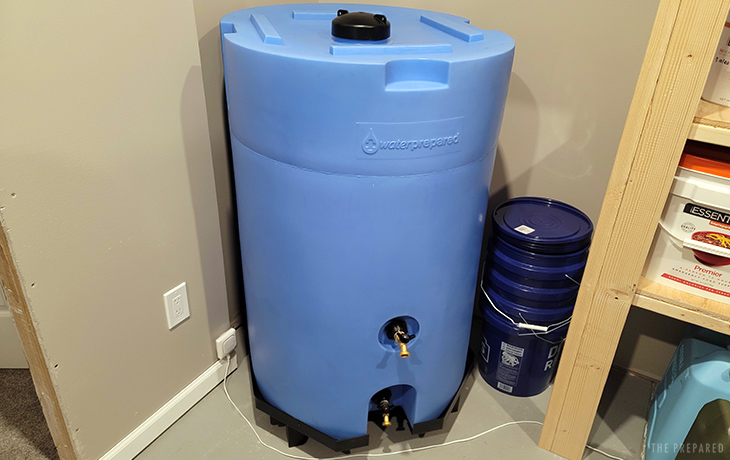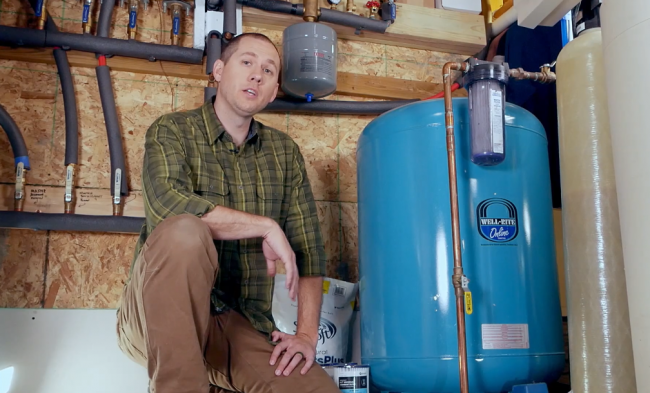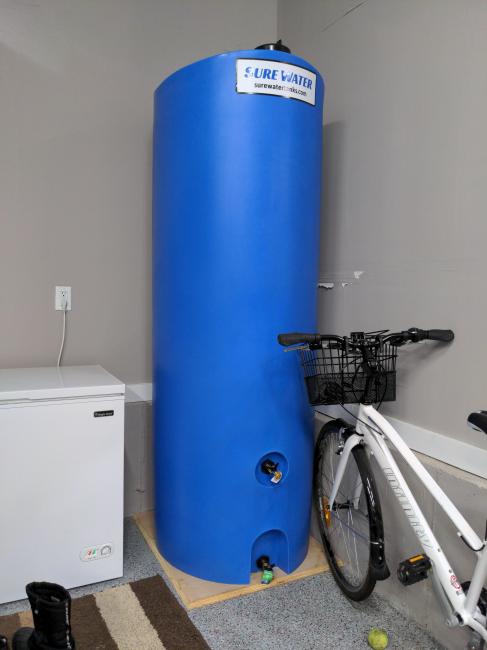Best large water barrels and tanks

-
Comments (12)
-
Doozer - January 10, 2021
Couldn’t you buy the appropriate tank and place it before your water line that enters the house? That way the water is constantly refreshed and you wouldn’t need to worry about it expiring or getting contaminated. I wonder if that would reduce the water pressure in the house?
-
John AdamaStaff - January 11, 2021
It’s possible, sure. That’s basically how water was moved through internal plumbing up through the first part of the 20th century — eg. a water tank on the roof of a multi-story building, where the force of gravity was enough to ‘pressurize’ the water through the pipes. But that’s also why older buildings were known for having inconsistent water pressure from one floor to another, for example.
In the new water essentials course we show a community member’s home where they have multiple thousand-gallon cisterns in their basement, which then feed into the house plumbing for that constant use-refresh-use cycle you mentioned.
But since they wanted great pressure, and especially since those cisterns are in the basement (below where the water needs to go, rather than above), the homeowner put a water pressurization device in their plumbing setup. So it goes: input from outside > cisterns > water treatment (an RO system in their case) > water pressurizer > into the main plumbing.
Here’s a quick screenshot of what that pressurization tank looks like:
-
phiguru - January 25, 2021
We have a slow-recharging well and so we mitigate that with a 500gal cistern. It isn’t our first choice for power loss (often) because it is harder to tap than a 5gal container. However, longer power outages, it is wonderful. Our is see-through (dark spot – never had any growth issue) and is rigged with low-water sensors that help trigger the pump and an alarm (again, this was for mitigating a well issue). However, I like that it is see through because I can see the water level and if I need to flush the system. Like a hot water heater, it does need periodic flushing because of gradual buildup of gunk from all the water passing through.
-
-
Alicia - January 25, 2021
Thanks for the update, John. I have a couple of 55 gallon food safe drums that as it turned out, didn’t have a fine thread bung necessary for a filter that works on pressurizing the drum and hand pump since it has no valve bibs. I’ve tried a few adaptors to no avail. Because of this, I’m sensitive to the specs of the entry bung. Do you know the specs of the filling cap for each of the barrels? It’s not listed on the Amazon site either. For the 30 gallon, it says 2 inches, but not the thread. One reviewer noted that it won’t take a bung wrench to help seal it tightly – I’m not as concerned about that function since I’m not shipping it full.
-
Thomas GomezStaff - January 28, 2021
Hello.
We reached out to both Smart Tank and Legacy Premium regarding our two picks. Both tanks use a 2 inch 20C cap with buttress threads. I asked both manufactures what the “20C” meant, and they said it was merely a part number, and the C stood for cap. They could not provide a thread for the buttress threads. Both companies said the 2 inch 20C cap was a fairly standard part, and the buttress thread size was usually the same. Strong hand pressure should be sufficient when tightening down these caps.
Hope this finds you well.
-
Alicia - January 29, 2021
Thanks for the followup and additional information.
-
Pops - February 17, 2021
Grainger carries lots of parts
I used bulkhead parts from this page to tap the bottom of 55gal barrels so several could be filled from one single point and drained from another single point.
-
-
Jeff P - March 2, 2021
We are planning to add a 250 gallon tank to our basement for emergency supply. We have water supply downstairs, but no drain (officially) due to city codes and the age of our house. The one drain we do have goes into our sump pit and is pump out into the yard away from the house. So, how important is it to change utility treated water on a yearly basis? Couldn’t I just recharge it with some bleach once a year?
-
Olly Wright - March 2, 2021
250 gallons sure will be a great addition to your preps!
Clean water (utility treated) that is put into a clean container without access to outside air, heat, or light will remain safe for years and years. Water doesn’t go bad, but if there are contaminates in it (like from unclean water or a container that isn’t cleaned all the way), then that is what could grow some harmful things.
Previously treated water doesn’t NEED to be treated again as long as you abide by those things I mentioned above. But certainly doesn’t hurt to treat or run through a filter or throw a bit more bleach in an hour before you need to drink it.
-
-
Ostrich eggs - March 23, 2022
Thank you for the great article. I bought one of the 260 gallon tanks from Sure Water because of your recommendation. It brings a whole nother level of comfort knowing that we have clean drinking water stored up.
It wasn’t too difficult to move into place when it was empty. The website says it weighs 2245 pounds when full and I’m trying to decide if I need to strap it to the wall to prevent it from tipping during an earthquake.
It isn’t much, but I placed it on a small piece of wood to get it up off the floor ever so slightly. In the future I will have to design a way to rise it up further. Wood pallets can hold around 2800 pounds, but I would want to reinforce that with additional supports to feel more comfortable.
-
jaybee - April 30, 2022
Question: I live alone with two dogs just outside of a large US city. I have about 30 gallons of store bought water for my dogs (stored in the basement where it’s dark and cool ) and 30 gallons in 5 gallon containers for me. I also have family living nearby (including a daughter with young baby), so I could see her coming to stay with me in an emergency situation. For that reason, I’m considering a 55 gallon drum in my basement. When it’s time to replace the water with fresh water I should be fine since I have a drain in my basement floor. My question is about filling! I have a hose that would reach to my basement for filling, but it’s not a potable hose. Will treating the water before sealing the barrel take care of that?
-
Robert LarsonContributor - April 30, 2022
As I was growing up, my parents would always just run the garden hose through the basement window to fill the drum in the food storage room. Then they applied a ton of new bleach to kill off anything growing in there. We never drank or tested that water, but I don’t remember anything funky growing in there.
Knowing now what I do, I would probably go buy a dedicated hose for filling. If you want to use an older hose, pour bleach into it, screw it to itself to make a large ring, and rotate the hose to distribute the bleach letting it sit for an hour to totally sanitize the inside. Then in your drum, I would add a bit extra then the recommended amount of bleach to make sure it’s all clean water.
-
-

